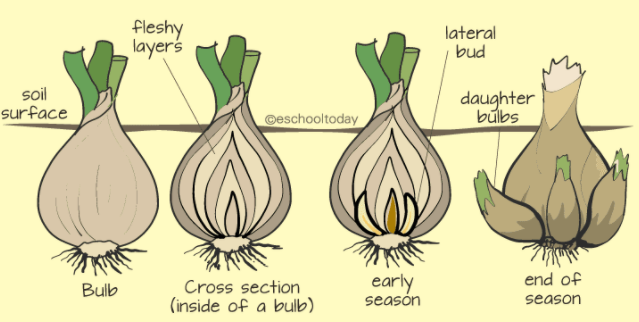Answer
425.1k+ views
Hint: Vegetative propagation is much faster than sexual reproduction in plants. This can be done artificially as well, which is widely employed in horticulture. Reproduction is the biological process by which new organisms known as the offspring are produced by their parents.
Complete answer:
Reproduction can be done by two methods: Sexual reproduction and asexual reproduction. The divergence between the two types lies in the number of parents required for both.
Plants reproduce asexually through their vegetative parts such as leaves, roots, stem, and buds. This is known as vegetative propagation. For example - onion bulbs, tubers of the potato, runners/stolon, etc.
Vegetative propagation is performed in the plants which do not have viable seeds or seeds which are dormant. Vegetatively propagated plants have desirable superior traits because it results in producing identical plants.
Plants that need intensive care for the period of the early stages of their development also are vegetatively propagated.

Additional information:
In asexual reproduction, a single parent can give birth to the offspring. Asexual reproduction is normally seen in plants but is less common in the animal kingdom.
In the Sexual type of reproduction in mammals, two parents are mandatory to give rise to the offspring.
Note: Various modes of asexual reproduction in organisms are budding in yeast, fragmentation in spirogyra, spore formation in fungi.
Examples of organisms undergoing regeneration are hydra or planaria.
Vegetative propagation is done usually by roots, by leaf, and by the stem, cutting, layering, and grafting.
Examples of vegetative propagation are banana, rose, jasmine, potato, bryophyllum, money plant, and tissue culture.
Complete answer:
Reproduction can be done by two methods: Sexual reproduction and asexual reproduction. The divergence between the two types lies in the number of parents required for both.
Plants reproduce asexually through their vegetative parts such as leaves, roots, stem, and buds. This is known as vegetative propagation. For example - onion bulbs, tubers of the potato, runners/stolon, etc.
Vegetative propagation is performed in the plants which do not have viable seeds or seeds which are dormant. Vegetatively propagated plants have desirable superior traits because it results in producing identical plants.
Plants that need intensive care for the period of the early stages of their development also are vegetatively propagated.

Additional information:
In asexual reproduction, a single parent can give birth to the offspring. Asexual reproduction is normally seen in plants but is less common in the animal kingdom.
In the Sexual type of reproduction in mammals, two parents are mandatory to give rise to the offspring.
Note: Various modes of asexual reproduction in organisms are budding in yeast, fragmentation in spirogyra, spore formation in fungi.
Examples of organisms undergoing regeneration are hydra or planaria.
Vegetative propagation is done usually by roots, by leaf, and by the stem, cutting, layering, and grafting.
Examples of vegetative propagation are banana, rose, jasmine, potato, bryophyllum, money plant, and tissue culture.
Recently Updated Pages
How many sigma and pi bonds are present in HCequiv class 11 chemistry CBSE

Why Are Noble Gases NonReactive class 11 chemistry CBSE

Let X and Y be the sets of all positive divisors of class 11 maths CBSE

Let x and y be 2 real numbers which satisfy the equations class 11 maths CBSE

Let x 4log 2sqrt 9k 1 + 7 and y dfrac132log 2sqrt5 class 11 maths CBSE

Let x22ax+b20 and x22bx+a20 be two equations Then the class 11 maths CBSE

Trending doubts
Fill the blanks with the suitable prepositions 1 The class 9 english CBSE

At which age domestication of animals started A Neolithic class 11 social science CBSE

Which are the Top 10 Largest Countries of the World?

Give 10 examples for herbs , shrubs , climbers , creepers

Difference between Prokaryotic cell and Eukaryotic class 11 biology CBSE

Difference Between Plant Cell and Animal Cell

Write a letter to the principal requesting him to grant class 10 english CBSE

Change the following sentences into negative and interrogative class 10 english CBSE

Fill in the blanks A 1 lakh ten thousand B 1 million class 9 maths CBSE



